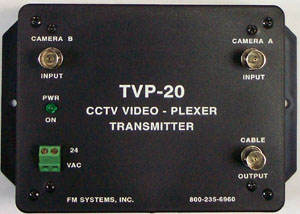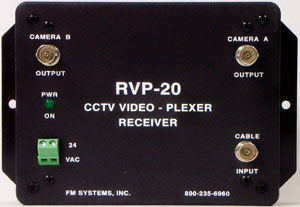HOW TO USE CCTV VIDEO DI-PLEXING
HOW TO USE CCTV VIDEO DI-PLEXING
By: Don McClatchie
FM SYSTEMS, INC.
What is Video Di-plexing?
The term “Di-plexing” refers to the combination of two signals into a single signal stream usually for transmission between two points. “CCTV Video Di-plexing” is the combination of two full frame real time video signals onto a single cable or twisted pair set of wires.
The term “multiplexing” is sometimes confused with “Di-plexing”. There are two general types of multiplexing, the first and most often used in CCTV is “Time Multiplexing”. In this type of Multiplexing two or more signals are combined for transmission or display on a monitor.
The big trade off with Time Multiplexing is that large numbers of video frames are discarded from each channel never to be retrieved again. This trade off is most evident when high speed motion occurs in the video, then the picture demonstrates a jerky motion artifact.
The other type of Multiplexing is Frequency Multiplexing. A frequency Multiplexer allows multiple signals to occupy the same cable or twisted pair wire set. This is done by operating each signal on a different frequency much like over the air broadcast has different frequencies for each TV station.
The Di-Plexer operates by frequency Multiplexing the two signals, this allows for full frame real time transmission of both video channels. Since the two channels operate in their own band they do not occupy the same space and so do not interfere with one another. This allows the two signals to deliver all the video information that comes out of each camera.
Frequency multiplexing requires a form of modulation. Like the FM Broadcast stations that use Frequency Modulation to deliver audio to your radios, a Di-plexer uses AM (Amplitude Modulation) to send the second video signal down the cable or twisted pair wire set.
Amplitude Modulation (AM) as the name implies uses the video signal to drive the level or (amplitude) of an RF carrier. The frequency of the carrier is set by the equipment. In the case of TVP-20 that carrier frequency is 20 Megahertz. So the “A” channel video occupies a bandwidth of 0-5 Megahertz and the “B” channel operates +/-5 Megahertz around the Carrier.
Notice that it is +/-5 Megahertz around the carrier, this refers to a type of AM modulation called double side-band modulation. This type of modulation has equal energy on both sides of the carrier that results in a frequency response advantage. While the “A” channel will experience the normal cable slope roll off caused by the cable length, this is very noticeable on long cable runs. The “B” channel will not exhibit any picture detail loss due to cable slope loss. In fact the picture will appear as though the cable was 1 foot long with no degradation of picture at all.
Another plus is the fact that the “A” channel is straight wire through, that is there are no amplifiers or electronics to block the signal in the event of a power failure. This also allows for Pan Tilt Zoom (PTZ) operation on the “A” camera using up the coax cable control. So one of the two cameras on the Di-plexer can be PTZ controlled.
CABLE IS CHEAP, SO WHY USE A VIDEO DI-PLEXER?
There are many applications where a video di-plexer is the right choice. This is controlled by the cost of making the connection between camera and monitor or DVR. If you can easily run a coaxial cable or twisted pair wire from a camera to the monitor, then that is the lowest cost way to install the run.
However if you need to lay conduit or if the run goes under a parking lot, cement driveway, inside a finished wall, or other obstructions, then it is a good idea to use any existing coax cable or twisted pair wire set to get the second camera through.
The sometimes hidden costs for repairing the entry and exit points of a cable can be time consuming and costly. Just connecting to an existing cable is especially useful when adding an additional camera to a system, just use the same cable for both cameras.
The cost of permits and jack hammers to break up the concrete, bust into the wall or cut finished surfaces makes the cost of a video di-plexer cheap at twice the price.
Not to mention your bids can be much more profitable and more numerous if you bid the job without having to tear up the customers premise just to put down another camera cable. You can submit your bid knowing that you can tap into the existing cables and get your job done without heavy construction. Think about the last job you did that required cutting and breaking, would that job have been more profitable if you hadn’t had to do that.
The TVP-20 and RVP-20 are transmitter and receiver video di-plexers specifically designed for the CCTV marketplace. Their low cost and ease of installation make it the perfect choice for fast additions to and existing CCTV system.


CLICK HERE to see more information
Keep a set to have on hand for emergencies. 1-800-235-6960


